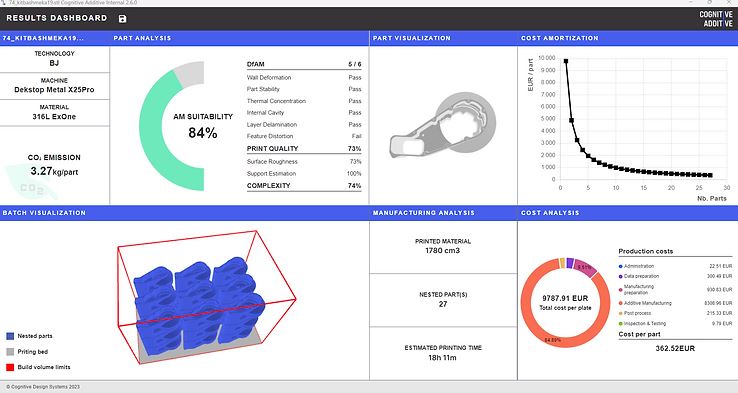Cognitive Design Systems, a pioneering technology company specializing in design and manufacturing optimization, is proud to announce the launch of its latest innovative software. This powerful solution represents a significant leap forward in leveraging AI for additive manufacturing technologies, empowering businesses to enhance productivity, streamline operations, reduce carbon footprint, and unlock new horizons in 3D printing.
Key Features of Cognitive Additive Software:
Carbon Footprint Calculator: Based on a cradle-to-gate approach, the software integrates an innovative carbon footprint calculator that provides businesses with a comprehensive assessment of their environmental impact when using additive technologies. Analyzing the energy consumption of machines, as well as the material usage, organizations can make informed decisions to minimize their carbon emissions.
New 3D printing technologies: Binder-based technologies such as Binder Jetting and Fused Filament Fabrication, are now available as part of Cognitive Additive. Users have the ability to compare multiple metal processes, understanding the distinct benefits of each, in order to make decisions regarding the most suitable technology for their manufacturing requirements. Each technique brings unique advantages to the table, offering opportunities for increased efficiency. For example, Binder Jetting allows for the printing of relatively large volumes with no support structures required and requires less post-processing compared to other additive methods. Furthermore, Fused Filament Fabrication (FFF) for metal is a more affordable technology often used for metal prototyping, contributing to cost-effectiveness. Additionally, Powder Bed Fusion (PBF) is a well-known and widely used fabrication method that ensures high performance and quality.
New Materials: Ceramics can now be used in Cognitive Additive, thereby expanding the range of available materials to three: polymer, metal, and ceramics. This advancement increases the versatility of the solution, offering the opportunity to leverage the distinct properties and applications offered by these three different material types.
New interface: The interface of the solution is also evolving, making it easier to comprehend the Design for Additive Manufacturing (DFAM) rules and visualize design flaws in each model.
To learn more about the software and explore its capabilities, please visit https://www.cognitive-design-systems.com/cognitive-additive.
Subscribe to AM Chronicle Newsletter to stay connected: https://bit.ly/3fBZ1mP
Follow us on LinkedIn: https://bit.ly/3IjhrFq
Visit for more interesting content on additive manufacturing: https://amchronicle.com


